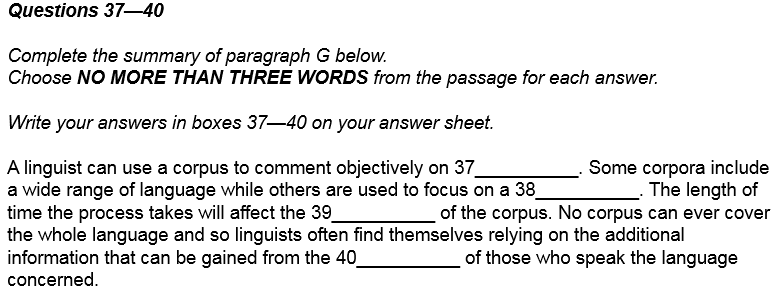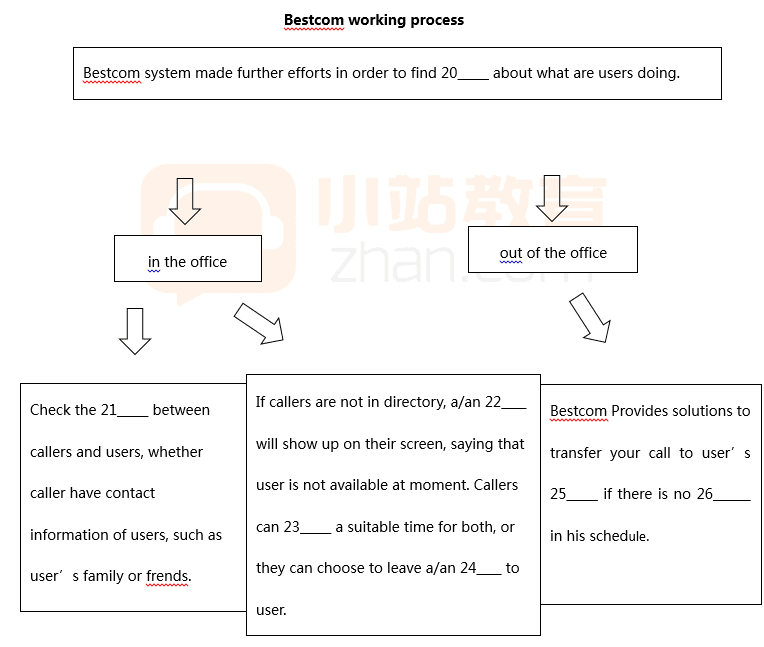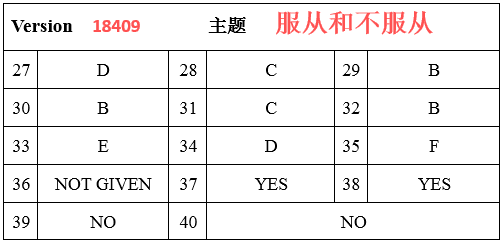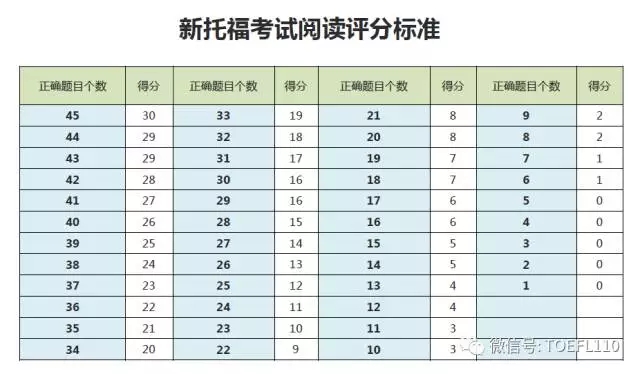gre考试长难句怎么读懂呢?今天小编给大家带来了gre考试长难句怎么读懂,希望能够帮助到大家,下面小编就和大家分享,来欣赏一下吧。
gre考试长难句怎么读懂
gre阅读长难句分析方法介绍
1、长成分
1)长从句做主语、宾语及其他成分
a、主语从句
b、宾语从句
2)长状语
3)层层修饰
4)并列成分
2、gre考试常见倒装搭配
(1)及物动词加介词:固定词组的固定搭配中,经常出现倒装情况,如:bring A to B,写作:bring to B A
例:Yet Waltzer’s argument , however deficient , does point to one of the most serious weaknesses of capitalism-namely , that it brings to predominant positions in a society people who ,no matter how legitimately they have earned their material rewards , often lack those other qualities that evoke affection or admiration.
类似的情况:throw over , insert into , import into , infer from, establish for , advocate as 等
(2)及物动词加副词
例:make possible …(单词或者句子)
3、省略的几种情况
(1)重复的成分
(2)让步转折的省略:如although (but)
(3)定语从句引导词的省略which(that )
(4)定语从句的引导词和系动词同时省略,变成后置定语
如:qualities(such as “the capacity for hard work”) essential in producing wealth
4、 gre阅读考试短语被分割
如:such as, so that , too to , more than , from A to B , between A and B
5、多重否定
如:Despite these vague categories , one should not claim unequivocally that hostility between recognizable classes cannot be legitimately observed .
6、难句分析举例
Such large, impersonal manipulation of capital and industry greatly increased the numbers and importance of shareholders as a class , an element in national life representing irresponsible wealth detached from the land and the duties of the landowners; and almost equally detached from the responsible management of business.
[句子主干]Such large, impersonal manipulation of capital and industry greatly increased …shareholders as a class, (which was) an element…
[语法难点]本句是典型的非限定性定语从句,难点在其主语和宾语都有较长的短语和of结构限定,并且分句是由两个and相连的3个部分组成的。分句an element…landowners 又带有两个定语从句,一个是(which was)representing… ,另一个是(which was)detached…。
可见,定语从句的难点在于经常省略“引导词+be”的结构,从而在理解上容易和分词结构相混淆。
[句子翻译] 对资本和企业的这种大规模的非个人操纵大大增加了股东作为一个阶级的数量和重要性。这个阶层作为国计民生的一部分,代表了非个人责任的财富与土地及土地所有者应尽义务的分离,而且也几乎与责任管理相分离。
GRE阅读怎么得高分
诸生读此类文章最大误区在于试图读懂,更有甚者,寻求文章之背景,遍寻译文,以期充分理解,虽有燃膏继晷之功,难有吴甲吞楚之效,盖此种文章,非为考生读懂而设计。更有甚者,仿阅读之结构,言辞,图作文之高分,则更加南辕北辙,缘木求鱼而已。请杀鸡诸位谨记:
这是考试,你只有13-15分钟做题,文章不是用来读懂的,对待长难句最好的办法是考虑怎么不读,少读,而不是分析。
学术文章特点就是规范,层次清晰,主题明确。
我们一定要读出套路,尤其是文章观点的数量,这个直接关系到主题题怎么出。
我们要把每段的层次的连词标记出来,我们还要知道每个层次的主题词是什么,周围有没有否定词(改善题),有没有褒贬的词(态度题,应用题)。
至于例子,也可以考虑不读或者少读,因为GRE阅读重点考观点,例子是事实,事实记得越多,混淆信息越多,做题越慢,准确率越低。对于例子,只要记住位置就可以,题目考到再看,不考坚决不看。以观点记例子,以观点分层次,以观点分逻辑关系。
GRE阅读正确的解题方法
读原文
GRE阅读的基本做题方法,就是先读原文再看题目,看过题目后再根据题目定位回原文,所以读原文是做一篇阅读的第一步。有些读者已经养成了先读题目再看原文的阅读习惯,其实,做题的顺序要因阅读特点和出题方式而异,GRE阅读题目的出题顺序和原文几乎没有任何联系,也就是说第一道题可能考了原文的末尾,而最后一道题可能考的是原文的开始,故先读题目再读原文对做题没有任何帮助,反而有可能扰乱读者理解原文内在的逻辑结构。
读原文的同时对重点、考点做标记
做标记是指在读文章的时候用简单的符号记录所读重点内容,这应该和读文章同步进行,标记可以轻轻做在试卷边缘,也可以另外写在草稿纸上。所标记的主要目的是为了读完选项之后能快速、准确的定位,这个步骤要求读者熟悉常考考点,对应做标记的内容烂熟于胸,这样才能不费时间的给自己下一步的定位作准标记。
读题干、选项
读题干的过程也是个找题干特征的过程,看看题干所述和自己所做标记的内容有没有联系,如果有,则可以直接定位,故定位最主要的基础是题干与标记之间的联系。有时候题干可能没有可以捕捉的特征,这时读者不妨从选项下手,选项中也时常会有明显的特征反映出它与原文中的重点内容之间的相关性。
定位
定位指的是确定练习题针对原文中什么位置的内容发问,通常通过题干和选项的特征词来找,判断了原文所述的位置之后,就可以找原文和答案之间的对应关系了,绝大多数题目都可以通过找题干和选项的特征词准确的定位到原文某处。
(排除干扰选项后)按文字对应原则选答案
GRE考试的备选答案都是五个,通常很少有练习题能让读者非常直接的判断出正确答案,总有1-2个迷惑性比较大的选项,所以,考生不妨先竖读各选相,排除一些明显错误的选项,然后再对剩下的进行细致的比较,通过原文和选项之间的文字对应关系,进行选择。
GRE阅读:Mary Barton
Mary Barton, particularly in its early chapters, is a moving response to the suffering of the industrial worker in the England of the 1840’s. What is most impressive about the book is the intense and painstaking effort made by the author, Elizabeth Gaskell, to convey the experience of everyday life in working-class homes. Her method is partly documentary in nature: the novel includes such features as a carefully annotated reproduction of dialect, the exact details of food prices in an account of a tea party, an itemized description of the furniture of the Bartons’ living room, and a transcription (again annotated) of the ballad “The Oldham Weaver.” The interest of this record is considerable, even though the method has a slightly distancing effect.
As a member of the middle class, Gaskell could hardly help approaching working-class life as an outside observer and a reporter, and the reader of the novel is always conscious of this fact. But there is genuine imaginative re-creation in her accounts of the walk in Green Heys Fields, of tea at the Bartons’ house, and of John Barton and his friend’s discovery of the starving family in the cellar in the chapter “Poverty and Death.” Indeed, for a similarly convincing re-creation of such families’ emotions and responses (which are more crucial than the material details on which the mere reporter is apt to concentrate), the English novel had to wait 60 years for the early writing of D. H. Lawrence. If Gaskell never quite conveys the sense of full participation that would completely authenticate this aspect of Mary Barton, she still brings to these scenes an intuitive rec.nition of feelings that has its own sufficient conviction.
The chapter “Old Alice’s History” brilliantly dramatizes the situation of that early generation of workers brought from the villages and the countryside to the urban industrial centers. The account of Job Legh, the weaver and naturalist who is devoted to the study of biol.y, vividly embodies one kind of response to an urban industrial environment: an affinity for living things that hardens, by its very contrast with its environment, into a kind of crankiness. The early chapters—about factory workers walking out in spring into Green Heys Fields; about Alice Wilson, remembering in her cellar the twig-gathering for brooms in the native village that she will never again see; about Job Legh, intent on his impaled insects—capture the characteristic responses of a generation to the new and crushing experience of industrialism. The other early chapters eloquently portray the development of the instinctive cooperation with each other that was already becoming an important tradition among workers.
13.1. Which of the following best describes the author’s attitude toward Gaskell’s use of the method of documentary record in Mary Barton?
(A) Uncritical enthusiasm
(B) Unresolved ambivalence
(C) Qualified approval
(D) Resigned acceptance
(E) Mild irritation
13.2. According to the passage, Mary Barton and the early novels of D. H. Lawrence share which of the following?
(A) Depiction of the feelings of working-class families
(B) Documentary objectivity about working-class circumstances
(C) Richly detailed description of working-class adjustment to urban life
(D) Imaginatively structured plots about working-class characters
(E) Experimental prose style based on working-class dialect
13.3. Which of the following is most closely anal.ous to Job Legh in Mary Barton, as that character is described in the passage?
(A) An entomol.ist who collected butterflies as a child
(B) A small-town attorney whose hobby is nature phot.raphy
(C) A young man who leaves his family’s dairy farm to start his own business
(D) A city dweller who raises exotic plants on the roof of his apartment building
(E) A union organizer who works in a textile mill under dangerous conditions
13.4. It can be inferred from examples given in the last paragraph of the passage that which of the following was part of “the new and crushing experience of industrialism” (lines 46-47) for many members of the English working class in the nineteenth century?
(A) Extortionate food prices
(B) Ge.raphical displacement
(C) Hazardous working conditions
(D) Alienation from fellow workers
(E) Dissolution of family ties
13.5. It can be inferred that the author of the passage believes that Mary Barton might have been an even better novel if Gaskell had
(A) concentrated on the emotions of a single character
(B) made no attempt to re-create experiences of which she had no firsthand knowledge
(C) made no attempt to reproduce working-class dialects
(D) grown up in an industrial city
(E) managed to transcend her position as an outsider
13.6. Which of the following phrases could best be substituted for the phrase “this aspect of Mary Barton” in line 29 without changing the meaning of the passage as a whole?
(A) the material details in an urban working-class environment
(B) the influence of Mary Barton on lawrence’s early work
(C) the place of Mary Barton in the development of the English novel
(D) the extent of the poverty and physical suffering among England’s industrial workers in the 1840’s
(E) the portrayal of the particular feelings and responses of working-class characters
13.7. The author of the passage describes Mary Barton as each of the following EXCEPT:
(A) insightful
(B) meticulous
(C) vivid
(D) poignant
(E) lyrical
gre考试长难句怎么读懂相关文章:
★ 备考GRE阅读究竟应该准备些什么
gre考试长难句怎么读懂
上一篇:gre考试阅读提分要参考什么
下一篇:返回列表






